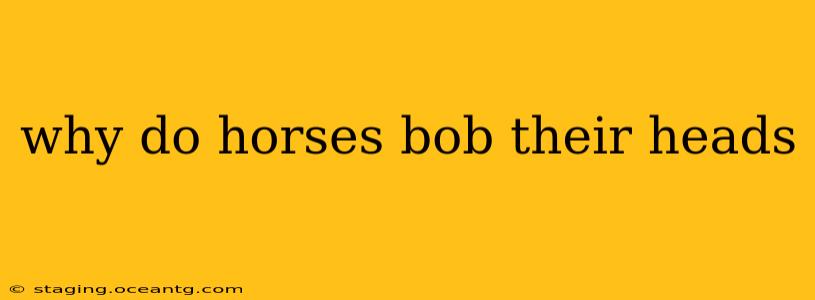Have you ever watched a horse walk and noticed its distinctive head bobbing motion? This seemingly simple action is actually a complex interplay of balance, vision, and coordination, far more intricate than it initially appears. While it might seem like a quirky habit, understanding why horses bob their heads helps us appreciate the remarkable adaptations these animals possess.
Why Do Horses Bob Their Heads When They Walk?
The primary reason horses bob their heads is to maintain their balance and visual stability while walking. Their heads act as a counterbalance to their relatively large and heavy bodies. As a horse's hind legs move forward, its head moves down, subtly shifting its center of gravity. Conversely, as the front legs move, the head rises, further stabilizing the entire body.
This coordinated movement is not merely a matter of instinct; it’s a sophisticated biomechanical process requiring exceptional coordination between the brain, eyes, and musculoskeletal system. The rhythmic bobbing helps the horse keep its gaze steady, despite the movement of its body, preventing visual disturbances and improving its ability to navigate its surroundings.
Think of it like a tightrope walker using a balancing pole: the head acts as that pole, constantly adjusting to keep the horse level and prevent stumbling. The smoother the gait, the more subtle and less noticeable the head bobbing will be. A horse with a more pronounced bob often has a less-refined gait.
What Other Factors Contribute to Head Bobbing?
While balance and vision are the primary drivers, other factors can influence a horse's head bobbing:
Are Certain Breeds More Prone to Head Bobbing?
While not specific to any single breed, the degree of head bobbing can vary due to conformation (the horse's structure and build). Horses with longer necks or those with certain musculoskeletal imbalances might exhibit more pronounced head bobbing. It's important to note that excessive or unusual head bobbing could signal a problem, which leads us to the next point.
Could Head Bobbing Indicate a Problem?
Yes, excessive or irregular head bobbing can be a sign of underlying problems. These might include:
- Vision problems: Difficulty seeing can lead to compensatory head movements to improve visual clarity.
- Neck or back pain: Pain can disrupt normal movement patterns, resulting in altered head carriage.
- Neurological issues: Conditions affecting the nervous system can also manifest as unusual head movements.
- Dental problems: Pain in the mouth can affect posture and gait, potentially leading to altered head movements.
If you notice unusual or excessive head bobbing in your horse, consult a veterinarian to rule out any underlying medical conditions.
Does a Horse's Head Bobbing Change with Different Gaits?
Yes, the degree of head bobbing changes with the gait. It's most noticeable during walking and is less pronounced or absent at faster gaits like trotting or cantering. This is because at faster gaits, the horse’s body has less time to move independently from the legs, reducing the need for the head as a counterbalance.
Can Training Affect Head Carriage and Bobbing?
Training can subtly influence head carriage but generally doesn't significantly alter the inherent head bobbing mechanism. Proper training focuses on promoting a relaxed and balanced posture, which may indirectly affect the subtle rhythm of the head movement. However, trying to consciously eliminate the head bobbing is generally considered unnatural and unproductive.
In summary, while seemingly simple, the head bobbing of a horse is a fascinating example of natural adaptation and biomechanical efficiency. It reflects the animal's remarkable ability to maintain balance and visual stability even while in motion. Understanding this intricate mechanism helps us better appreciate the complex workings of these majestic creatures.
